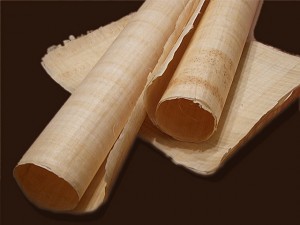Making Papyrus Paper
An ancient form of writing material derived from the plant of the same name, papyrus was important in the development of paper production.
Papyrus paper was made by taking multiple stems from the Cyperus papyrus plant, a grasslike aquatic species with woody triangular stems that grew commonly down the banks of the Nile delta region in Egypt. The fibrous stem layers within are extracted and sliced into thin strips. These strips are laid out in rows topped with another layer of strips arranged at right angles.
The layers are then dampened and pressed together into a sheet. This sheet of pressed strips is then left out in the sun to dry, forcing the plant’s sticky, glue-like sap to act as an adhesive and cementing the layers together.
Finally, the dried sheet of stems is hammered and pasted together with others to form a roll of paper ready for writing, drawing or even painting.
 It was the ancient Egyptians (from the third millennium BC) who caused the proliferation of papyrus, due to the sheer quantities of the plant available to them.
It was the ancient Egyptians (from the third millennium BC) who caused the proliferation of papyrus, due to the sheer quantities of the plant available to them.
However, the technique soon spread throughout the Mediterranean and was used commonly by the Greeks. Indeed, many ancient documents emanating from the area are all written on papyrus and examples of its use have been recorded as late as the 12th Century from the Byzantine Empire.
While papyrus in hot climates provided a cheap, stable and largely deteriation-proof writing surface, that was easier to transport over long distances than tablets or animal skins, its tendency to mould in damp conditions and crack if bent led its use to be restricted. Papyrus was eventually replaced by parchment and vellum, which offered greater durability and a much smoother writing surface.
Read also Egyptian Papyrus , How to Make Papyrus , How Ancient Papyrus Was Made and Ancient Egyptians made their own paper

